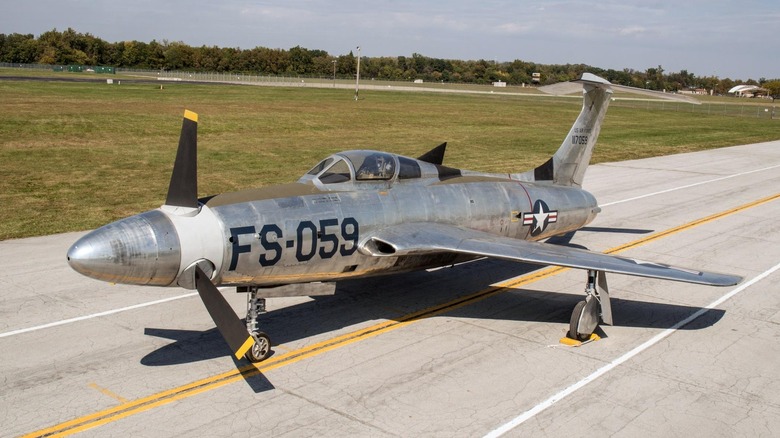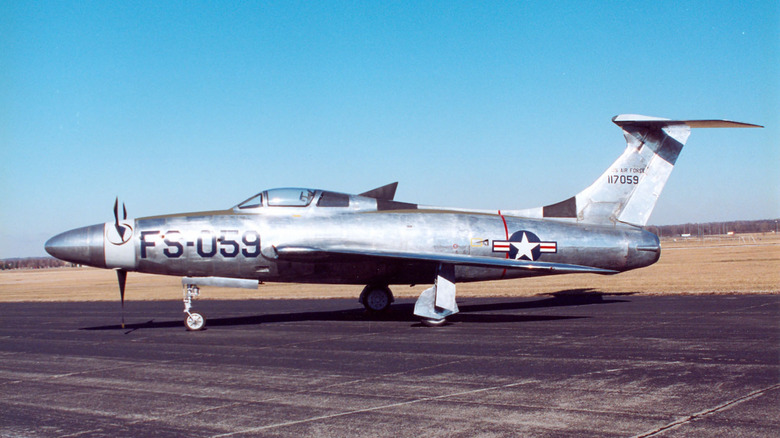Why Blade Tip Speed Hinders The Top Speed Of Propeller Planes
It's fairly common knowledge that when a supersonic aircraft approaches the sound barrier, what follows is the sonic boom. This transitory period between subsonic and supersonic, known as transonic speeds, results in various changes in airflow that affect the plane's entire structure. It took years of iterative engineering and testing before we were able to reliably overcome this hurdle.
Imagine a scenario in which a propeller-driven aircraft approaches a supersonic speed. By necessity, this would involve incredible linear velocities on such a propeller — meaning the distance the blades themselves cover when moving through the air. This means there are two methods by which to create an ultra-fast propeller: either make a stubby propeller that spins extremely quickly, or a massive propeller that spins just quickly enough that the blade tips break the sound barrier. While this sounds like a good idea in theory, it fails in three key areas.
The first reason why the tip speed is limited is easy enough: It's pure momentum. The forces acting on prop blades are so great that the blades themselves can't take the stress. But the second and third are more complex, and we'll discuss those in greater detail. Those are that propeller blade geometry is inefficient at ultra-high speeds and that supersonic propellers are essentially impossible to engineer in a way that doesn't generate obscene levels of noise. Let's explore each of these key points in detail, starting with a brief overview of the physics behind airfoils.
Propellers become less efficient the closer the blades are to transonic velocities
The way propellers work is that each blade acts as its own "wing," generating forward thrust by effectively boring its way through the air, much like a screw bores into wood. Propellers are twisted in such a way to maximize efficiency based on how fast each section of the blade is — the tip moves the fastest and features a shallow, thin profile compared to the thick, heavily angled root. Moreover, the overall angle of the propeller changes mid-flight in variable-pitch designs, increasing or decreasing the angle at which the blades hit the air, known as the propeller's angle of attack.
All of this relies on two important factors: the speed of the propeller itself and the thickness of the substance it's trying to move through. Let's say a propeller reaches transonic speeds. What happens is that the air pressure around the blade tips changes drastically. The air becomes highly compressible, forming unstable air pockets that flow off the propeller. This drastically increases a propeller's drag while negatively impacting its thrust because it can't bite into the air as effectively. It may even cause the propeller to stall because the pressure contour, or the variations of air pressure along the airfoil, becomes disturbed by these interactions.
Some aircraft use transonic propellers, though only one is particularly well-known: the Tupolev Tu-95 "Bear." Its eight propellers spin at 750 rpm at full tilt with the tips achieving Mach 1.08; the main reason these propellers maintain efficiency is that they have four sets of two contra-rotating pairs. Each pair features a net efficiency increase over single-props of about 15%; this results in the Bear claiming the record of the world's fastest propeller-driven aircraft.
Stubby, fast propellers don't work, either
The Tu-95's propellers are massive, deriving much of their speed from their sheer size. But what about spinning a smaller propeller extremely quickly? This results in a greater blade cross-section becoming supersonic, meaning both the base and tip of the blade are moving at ultra-high speed. Such a concept has also been thoroughly tested by the United States, forming the basis of the world's most obnoxious aircraft.
Enter the XF-84, better known as the "Thunderscreech" due to the ungodly noise it produced, even when taxiing. It was and likely will remain the loudest aircraft ever built. The sound of a sonic boom is no joke; imagine experiencing that rumble constantly on the ground. It was so tremendous that it caused personnel working around the aircraft to get knocked over, have seizures, and become physically ill from the bombardment of 900 sonic booms per second. And that's not to mention that the propeller's phenomenal torque could overpower the pilot's ability to control the aircraft at altitude. Somehow, this monstrosity was expected to operate from carriers as well.
While the Thunderscreech is unquestionably an interesting anomaly of postwar high-speed aircraft design, it demonstrates why jets aren't a good idea, even if building an ultra-high-speed propeller-driven airframe is feasible. Put simply, propellers in general drop in efficiency the faster they go. Moreover, making supersonic propellers requires not just massive engines, but highly specialized and extremely loud prop blades. The benefits of propeller-driven aircraft are most abundant at low speeds, allowing so-equipped airframes to take off and land in short distances — one reason why the U.S. military still uses some prop-driven aircraft today.


